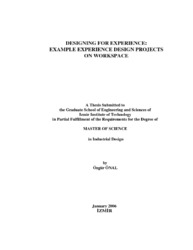Please use this identifier to cite or link to this item:
https://hdl.handle.net/11147/3279Full metadata record
| DC Field | Value | Language |
|---|---|---|
| dc.contributor.advisor | Özcan, A. Can | en |
| dc.contributor.author | Önal, Özgür | - |
| dc.date.accessioned | 2014-07-22T13:51:13Z | - |
| dc.date.available | 2014-07-22T13:51:13Z | - |
| dc.date.issued | 2006 | en |
| dc.identifier.uri | http://hdl.handle.net/11147/3279 | - |
| dc.description | Thesis (Master)--Izmir Institute of Technology, Industrial Design, Izmir, 2006 | en |
| dc.description | Includes bibliographical references (leaves: 94-95) | en |
| dc.description | Text in English; Abstract: Turkish and English | en |
| dc.description | xv, 96 leaves | en |
| dc.description.abstract | The great experiences can be deliberate and are based upon principles that have been proven. This thesis study explored the most important of these principles before the practical study. After that, the study focused on making a practical study on the workspace domain in three main phases.In the data collecting phase, experience data was collected for a workspace domain by observing workspace activities. Used methods were photographing, informal interviews, field notes and ethnographic observation. In the data modeling phase, a data model were constructed. Pattern language was used as a base for re-modeling the experience data. The data model is simply a framework that allows the designer to document, collect, communicate and understand all design related information quickly and easily. During the design phase, this framework became the design guideline and was used as a roadmap for every single design idea.Framework also gives the opportunity of defining relations from patterns to patterns and from design ideas to patterns. This flexible opportunity lets the designer visualize experience scenarios with design ideas in a higher level of understanding. Framework has a special data encapsulation format which is inherited from pattern language. According to that format, short pattern names, short essence paragraphs and other sections makes easier to remember, communicate and connect the patterns with new ideas. At the end of the design phase, three different products which are actively related with the experience patterns were designed. | en |
| dc.language.iso | en | en_US |
| dc.publisher | Izmir Institute of Technology | en |
| dc.rights | info:eu-repo/semantics/openAccess | en_US |
| dc.subject.lcc | TS171.4 .O58 2006 | en |
| dc.subject.lcsh | Design, Industrial | en |
| dc.subject.lcsh | Offices--Designs and plans | en |
| dc.title | Designing for experience: Example experience design projects on workspace | en_US |
| dc.type | Master Thesis | en_US |
| dc.institutionauthor | Önal, Özgür | - |
| dc.department | Thesis (Master)--İzmir Institute of Technology, Industrial Design | en_US |
| dc.relation.publicationcategory | Tez | en_US |
| item.languageiso639-1 | en | - |
| item.fulltext | With Fulltext | - |
| item.openairecristype | http://purl.org/coar/resource_type/c_18cf | - |
| item.openairetype | Master Thesis | - |
| item.grantfulltext | open | - |
| item.cerifentitytype | Publications | - |
| Appears in Collections: | Master Degree / Yüksek Lisans Tezleri | |
Files in This Item:
| File | Description | Size | Format | |
|---|---|---|---|---|
| T000385.pdf | MasterThesis | 6.46 MB | Adobe PDF |  View/Open |
CORE Recommender
Page view(s)
102
checked on Jul 22, 2024
Download(s)
46
checked on Jul 22, 2024
Google ScholarTM
Check
Items in GCRIS Repository are protected by copyright, with all rights reserved, unless otherwise indicated.